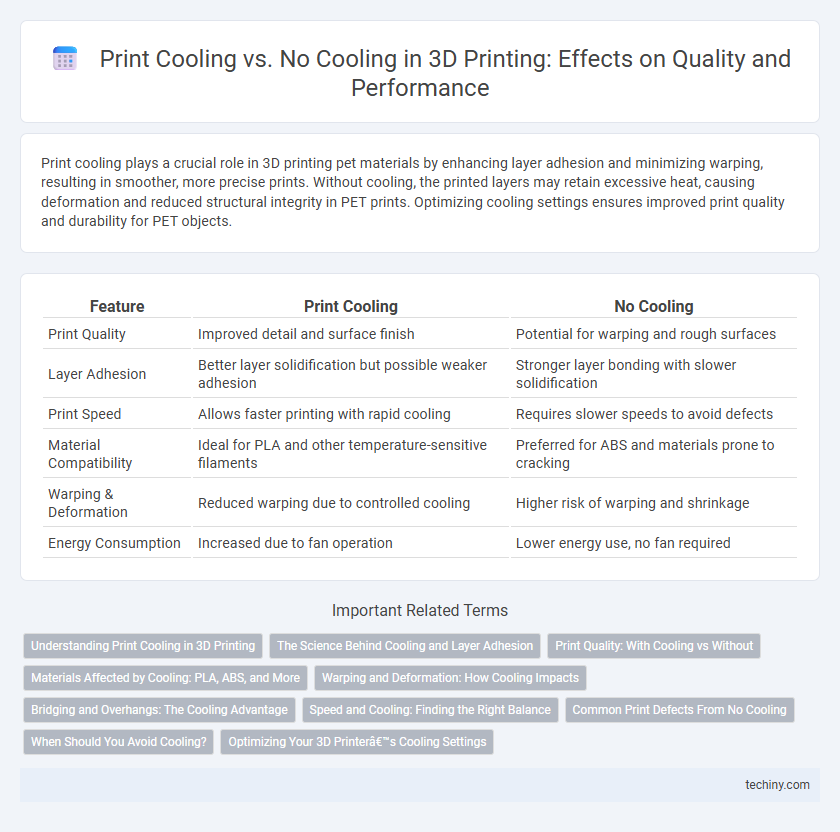Print cooling plays a crucial role in 3D printing pet materials by enhancing layer adhesion and minimizing warping, resulting in smoother, more precise prints. Without cooling, the printed layers may retain excessive heat, causing deformation and reduced structural integrity in PET prints. Optimizing cooling settings ensures improved print quality and durability for PET objects.
Table of Comparison
| Feature | Print Cooling | No Cooling |
|---|---|---|
| Print Quality | Improved detail and surface finish | Potential for warping and rough surfaces |
| Layer Adhesion | Better layer solidification but possible weaker adhesion | Stronger layer bonding with slower solidification |
| Print Speed | Allows faster printing with rapid cooling | Requires slower speeds to avoid defects |
| Material Compatibility | Ideal for PLA and other temperature-sensitive filaments | Preferred for ABS and materials prone to cracking |
| Warping & Deformation | Reduced warping due to controlled cooling | Higher risk of warping and shrinkage |
| Energy Consumption | Increased due to fan operation | Lower energy use, no fan required |
Understanding Print Cooling in 3D Printing
Print cooling in 3D printing significantly affects the quality and precision of the final object by regulating the solidification rate of the filament. Proper cooling prevents warping, stringing, and sagging by allowing layers to solidify quickly and maintain their shape during deposition. Optimizing cooling settings for materials like PLA, ABS, or PETG ensures improved layer adhesion, surface finish, and dimensional accuracy, making it a critical factor in successful 3D prints.
The Science Behind Cooling and Layer Adhesion
Effective print cooling in 3D printing directly influences layer adhesion by controlling the solidification rate of extruded filament, which affects the interlayer bonding strength. Insufficient cooling can cause layers to remain partially molten, enhancing layer fusion but risking warping and deformation, whereas optimal cooling solidifies layers quickly to maintain shape accuracy but may reduce adhesion quality if overdone. Understanding the balance in cooling parameters is crucial to ensure structural integrity and surface finish in FDM prints, as thermal gradients impact polymer crystallization and molecular entanglement at the layer interface.
Print Quality: With Cooling vs Without
Print cooling significantly enhances print quality by reducing warping, stringing, and layer misalignment through rapid solidification of filament, resulting in sharper details and smoother surfaces. Without cooling, prints often exhibit poor layer adhesion, excessive blobs, and deformation due to prolonged filament softening, which compromises dimensional accuracy. Optimal cooling settings vary by material, with PLA benefiting most from active cooling, whereas ABS requires minimal or no cooling to prevent layer cracking.
Materials Affected by Cooling: PLA, ABS, and More
Cooling plays a critical role in 3D printing quality, particularly affecting materials like PLA and ABS. PLA benefits significantly from active cooling, which enhances layer adhesion and reduces warping, while ABS often requires minimal or no cooling to prevent cracking and ensure proper layer bonding. Other materials, such as PETG and TPU, exhibit varied cooling needs that depend on their thermal properties, demanding tailored cooling strategies to optimize print strength and surface finish.
Warping and Deformation: How Cooling Impacts
Print cooling significantly reduces warping and deformation by solidifying the filament quickly, which stabilizes the object's shape during printing. Without adequate cooling, the material remains soft longer, causing layers to shift and leading to dimensional inaccuracies. Effective cooling is essential for maintaining precision and structural integrity in 3D printed parts, especially with materials like PLA.
Bridging and Overhangs: The Cooling Advantage
Effective print cooling significantly improves bridging and overhang quality by solidifying filament faster, reducing sagging and stringing during the printing process. Without cooling, melted filament remains soft longer, causing drooping and deformation in unsupported structures. Utilizing targeted cooling fans enhances dimensional accuracy and surface finish in complex geometries featuring bridges and overhangs.
Speed and Cooling: Finding the Right Balance
Optimizing print cooling in 3D printing directly influences print speed and quality, with excessive cooling potentially causing layer adhesion issues and insufficient cooling leading to deformation. Balancing fan speed and part cooling settings ensures faster print times while maintaining structural integrity, particularly with materials like PLA that benefit from active cooling. Advanced printers with adaptive cooling profiles allow for dynamic adjustments, promoting optimal solidification speed and minimizing defects in complex geometries.
Common Print Defects From No Cooling
Lack of print cooling in 3D printing often causes defects such as warping, stringing, and poor layer adhesion due to insufficient solidification time. Overheated layers can lead to sagging and blobbing, reducing overall print quality and dimensional accuracy. Ensuring proper cooling improves surface finish and structural integrity by stabilizing extrusion flow and preventing thermal deformation.
When Should You Avoid Cooling?
Avoid cooling during 3D printing when working with materials prone to warping or cracking, such as ABS, as rapid cooling can cause layer separation and weak adhesion. High-temperature filaments like PETG also benefit from reduced or no cooling to improve layer bonding and prevent surface defects. In contrast, PLA generally requires active cooling for optimal print quality, so avoiding cooling is mainly reserved for materials sensitive to thermal shock.
Optimizing Your 3D Printer’s Cooling Settings
Optimizing your 3D printer's cooling settings significantly impacts print quality and material performance. Enabling print cooling enhances layer adhesion, reduces stringing, and prevents warping, especially with PLA and other thermoplastics requiring rapid solidification. Conversely, disabling cooling for materials like ABS or PETG preserves layer strength and reduces cracking, highlighting the need to tailor cooling based on filament type and print complexity.
Print Cooling vs No Cooling Infographic

 techiny.com
techiny.com